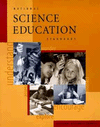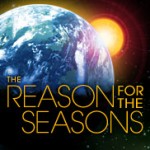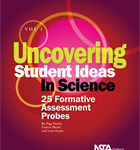The Sun is the primary source of energy for Earth’s climate system is the first of seven Essential Principles of Climate Sciences. Principle 1 sets the stage for understanding the Earth’s climate system and energy balance. In this article we provide a list of learning objectives and excerpts from the National Science Education Standards that are associated with Principle 1 concepts.
We also provide information on some common misconceptions on light, heat, and the seasons, plus tools for formative assessment and ideas for teaching these scientific concepts. You can read more about the science content knowledge needed to understand these concepts in the Beyond Weather and the Water Cycle article The Sun: Earth’s Primary Energy Source.
 National Science Education Standards
National Science Education Standards
A study of the Sun, energy, and the seasons aligns with the Physical Science, Earth and Space Science, and the Science in Personal and Social Perspectives content standards of the National Science Education Standards for Grades K-4 and 5-8.
Grades K-4 Physical Science Content Standard B
As a result of the activities in grades K-4, all students should develop an understanding of
LIGHT and HEAT
- Light travels in a straight line until it strikes an object. Light can be reflected by a mirror, refracted by a lens, or absorbed by the object.
- Heat can be produced in many ways, such as burning, rubbing, or mixing one substance with another. Heat can move from one object to another by conduction.
Developing Student Understanding
Physical science in grades K-4 includes topics that give students a chance to increase their understanding of the characteristics of objects and materials that they encounter daily. Through the observation, manipulation, and classification of common objects, children reflect on the similarities and differences of the objects. Young children begin their study of matter by examining and qualitatively describing objects and their behavior. The important but abstract ideas of science, such as atomic structure of matter and the conservation of energy, all begin with observing and keeping track of the way the world behaves. When carefully observed, described, and measured, the properties of objects, changes in properties over time, and the changes that occur when materials interact provide the necessary precursors to the later introduction of more abstract ideas in the upper grade levels.
Grades K-4 Earth and Space Science Content Standard D
As a result of their activities in grades K-4, all students should develop an understanding of
OBJECTS IN THE SKY
- The sun, moon, stars, clouds, birds, and airplanes all have properties, locations, and movements that can be observed and described.
- The sun provides the light and heat necessary to maintain the temperature of the earth.
Developing Student Understanding
Young children are naturally interested in everything they see around them – soil, rocks, streams, rain, snow, clouds, rainbows, sun, moon, and stars. During the first years of school, they should be encouraged to observe closely the objects and materials in their environment, note their properties, distinguish one from another and develop their own explanations of how things become the way they are. As children become more familiar with their world, they can be guided to observe changes, including cyclic changes, such as night and day and the seasons; predictable trends, such as growth and decay, and less consistent changes, such as weather or the appearance of meteors. Children should have opportunities to observe rapid changes, such as the movement of water in a stream, as well as gradual changes, such as the erosion of soil and the change of the seasons. Emphasis in grades K-4 should be on developing observation and description skills and the explanations based on observations. Younger children should be encouraged to talk about and draw what they see and think. Older students can keep journals, use instruments, and record their observations and measurements.
Grades K-4 Science in Personal and Social Perspectives Content Standard F
As a result of activities in grades K-4, all students should develop understanding of
CHANGES IN ENVIRONMENTS
- Environments are the space, conditions, and factors that affect an individual’s and a population’s ability to survive and their quality of life.
- Changes in environments can be natural or influenced by humans. Some changes are good, some are bad, and some are neither good nor bad. Pollution is a change in the environment that can influence the health, survival, or activities of organisms, including humans.
- Some environmental changes occur slowly, and others occur rapidly. Students should understand the different consequences of changing environments in small increments over long periods as compared with changing environments in large increments over short periods.
SCIENCE AND TECHNOLOGY IN LOCAL CHALLENGES
- People continue inventing new ways of doing things, solving problems, and getting work done. New ideas and inventions often affect other people; sometimes the effects are good and sometimes they are bad. It is helpful to try to determine in advance how ideas and inventions will affect other people.
Developing Student Understanding
Students in elementary school should have a variety of experiences that provide initial understandings for various science-related personal and societal challenges. Central ideas related to health, populations, resources, and environments provide the foundations for students’ eventual understandings and actions as citizens. Although the emphasis in grades K-4 should be on initial understandings, students can engage in some personal actions in local challenges related to science and technology.
By grades 3 and 4, students regard pollution as something sensed by people and know that it might have bad effects on people and animals. Children at this age usually do not consider harm to plants as part of environmental problems; however, recent media attention might have increased students’ awareness of the importance of trees in the environment. In most cases, students recognize pollution as an environmental issue, scarcity as a resource issue, and crowded classrooms or schools as population problems. Most young students conceive of these problems as isolated issues that can be solved by dealing with them individually. For example, pollution can be solved by cleaning up the environment and producing less waste, scarcity can be solved by using less, and crowding can be solved by having fewer students in class or school. However, understanding the interrelationships is not the priority in elementary school.
As students expand their conceptual horizons across grades K-12, they will eventually develop a view that is not centered exclusively on humans and begin to recognize that individual actions accumulate into societal actions. Eventually, students must recognize that society cannot afford to deal only with symptoms: The causes of the problems must be the focus of personal and societal actions.
Grades 5-8 Physical Science Content Standard B
As a result of their activities in grades 5–8, all students should develop an understanding of
TRANSFER OF ENERGY
- Energy is a property of many substances and is associated with heat, light, electricity, mechanical motion, sound, nuclei, and the nature of a chemical. Energy is transferred in many ways.
- Light interacts with matter by transmission (including refraction), absorption, or scattering (including reflection).
- The sun is a major source of energy for changes on the earth’s surface. The sun loses energy by emitting light. A tiny fraction of that light reaches the earth, transferring energy from the sun to the earth. The sun’s energy arrives as light with a range of wavelengths, consisting of visible light, infrared, and ultraviolet radiation.
Developing Student Understanding
The understanding of energy in grades 5-8 will build on the K-4 experiences with light, heat, sound, electricity, magnetism, and the motion of objects. In 5-8, students begin to see the connections among those phenomena and to become familiar with the idea that energy is an important property of substances and that most change involves energy transfer. Students might have some of the same views of energy as they do of force – that it is associated with animate objects and is linked to motion. In addition, students view energy as a fuel or something that is stored, ready to use, and gets used up. The intent at this level is for students to improve their understanding of energy by experiencing many kinds of energy transfer.
Grades 5-8 Earth and Space Science Content Standard D
As a result of their activities in grades 5-8, all students should develop an understanding of
EARTH IN THE SOLAR SYSTEM
- The sun is the major source of energy for phenomena on the earth’s surface, such as growth of plants, winds, ocean currents, and the water cycle. Seasons result from variations in the amount of the sun’s energy hitting the surface, due to the tilt of the earth’s rotation on its axis and the length of the day.
Developing Student Understanding
The understanding that students gain from their observations in grades K-4 provides the motivation and the basis from which they can begin to construct a model that explains the visual and physical relationships among earth, sun, moon, and the solar system. Direct observation and satellite data allow students to conclude that earth is a moving, spherical planet, having unique features that distinguish it from other planets in the solar system. From activities with trajectories and orbits and using the earth-sun-moon system as an example, students can develop the understanding that gravity is a ubiquitous force that holds all parts of the solar system together. Energy from the sun transferred by light and other radiation is the primary energy source for processes on earth’s surface and in its hydrosphere, atmosphere, and biosphere.
By grades 5-8, students have a clear notion about gravity, the shape of the earth, and the relative positions of the earth, sun, and moon. Nevertheless, more than half of the students will not be able to use these models to explain the phases of the moon, and correct explanations for the seasons will be even more difficult to achieve.
Grades 5-8 Science in Personal and Social Perspectives Content Standard F
As a result of activities in grades 5-8, all students should develop understanding of
NATURAL HAZARDS
- Human activities also can induce hazards through resource acquisition, urban growth, land-use decisions, and waste disposal. Such activities can accelerate many natural changes.
RISKS AND BENEFITS
- Risk analysis considers the type of hazard and estimates the number of people that might be exposed and the number likely to suffer consequences. The results are used to determine the options for reducing or eliminating risks.
- Students should understand the risks associated with natural hazards (fires, floods, tornadoes, hurricanes, earthquakes, and volcanic eruptions), with chemical hazards (pollutants in air, water, soil, and food), with biological hazards (pollen, viruses, bacterial, and parasites), social hazards (occupational safety and transportation), and with personal hazards (smoking, dieting, and drinking).
- Individuals can use a systematic approach to thinking critically about risks and benefits. Examples include applying probability estimates to risks and comparing them to estimated personal and social benefits.
- Important personal and social decisions are made based on perceptions of benefits and risks.
Developing Student Understanding
By grades 5-8, students begin to develop a more conceptual understanding of ecological crises. For example, they begin to realize the cumulative ecological effects of pollution. By this age, students can study environmental issues of a large and abstract nature, for example, acid rain or global ozone depletion. However, teachers should challenge several important misconceptions, such as anything natural is not a pollutant, oceans are limitless resources, and humans are indestructible as a species.
Little research is available on students’ perceptions of risk and benefit in the context of science and technology. Students sometimes view social harm from technological failure as unacceptable. On the other hand, some believe if the risk is personal and voluntary, then it is part of life and should not be the concern of others (or society). Helping students develop an understanding of risks and benefits in the areas of health, natural hazards – and science and technology in general – presents a challenge to middle-school teachers.
Middle-school students are generally aware of science-technology-society issues from the media, but their awareness is fraught with misunderstandings. Teachers should begin developing student understanding with concrete and personal examples that avoid an exclusive focus on problems.
Note: Read the entire National Science Education Standards online for free or register to download the free PDF. The content standards are found in Chapter 6.
Misconceptions
Misconceptions are referred to as preconceived notions, nonscientific beliefs, naive theories, mixed conceptions, or conceptual misunderstandings. Basically, in science these are cases in which something a person knows and believes does not match what is known to be scientifically correct.
Misconceptions may form as individuals attempt to make sense of the natural world, or as a result of the difference between scientific and everyday language. In other cases, misconceptions may actually form or be strengthened as a result of instruction. Once formed, these misconceptions can be tenacious – persisting even in the face of discrepant events or careful instruction. Research has documented that students may be able to provide the “correct” answer in science class yet still not abandon their previously formed idea.
Even though targeting student misconceptions is difficult, teachers should be cognizant of their students’ beliefs before, during, and after instruction. Formative assessment can provide insight and guidance for planning lessons and meeting student needs.
Misconceptions about Light
Misconceptions about light include the nature of light, the speed at which light travels, the behavior of light, image formation, and color. In keeping with our focus on Principle 1, we focus on the reflection and absorption of light as well as the light from the Sun. A common misconception is that light can only be reflected from shiny surfaces (such as a mirror). Students may also believe that an object cannot absorb and reflect light – it must do one or the other. Of course, the correct concept is that all objects absorb and reflect light to different degrees.
Another related misconception is that the Earth gets heat from the Sun. The Sun is actually too far from the Earth to heat it directly. Instead, the light from the Sun is reflected or absorbed by objects on Earth. Absorbed light usually increases the energy in an object, causing the object to heat up.
Misconceptions about Seasons
 Understanding why the Earth has seasons is one of the most difficult concepts for students to understand, and it is often a battle to get them to abandon their preconceived ideas. Two widely held misconceptions are:
Understanding why the Earth has seasons is one of the most difficult concepts for students to understand, and it is often a battle to get them to abandon their preconceived ideas. Two widely held misconceptions are:
- Earth’s orbit brings it closer to the Sun in summer and farther away in winter. This idea neglects the fact that at any given time the Northern and Southern Hemispheres experience opposite seasons. In fact, Earth’s orbit is actually nearly circular, and so variations in distance from the Sun have little effect compared to the effects of changes in the angle of incoming sunlight.
- The hemisphere that is tilted toward the Sun experiences summer because it is closer to the Sun. Actually, Earth is so small compared to the Sun, and so far away from it, that the difference in distance between the two hemispheres and the Sun is inconsequential. However, the tilt of Earth’s axis does affect the angle at which the Sun’s rays strike Earth, called the angle of incidence, and this is what causes the seasons.
Interviews with Harvard graduates in the late 1980s illustrate how widespread these misconceptions about the seasons are. When asked what causes the seasons, most of the newly graduated students gave the same wrong answer that many people give: the seasons are caused by Earth getting closer (or farther) from the Sun.
 What do your students think? A free, downloadable formative assessment probe from Volume 1 of Uncovering Student Ideas in Science helps you understand your students’ beliefs about the reflection of light (click on the link and scroll down to Details: Read a Sample Chapter). In the probe “Can It Reflect Light?” students are asked to decide which objects will reflect light and then share their thinking. The probe includes related research and suggestions for instruction and assessment.
What do your students think? A free, downloadable formative assessment probe from Volume 1 of Uncovering Student Ideas in Science helps you understand your students’ beliefs about the reflection of light (click on the link and scroll down to Details: Read a Sample Chapter). In the probe “Can It Reflect Light?” students are asked to decide which objects will reflect light and then share their thinking. The probe includes related research and suggestions for instruction and assessment.
In addition, we’ve followed the model used by Page Keeley and coauthors in the four volumes of Uncovering Student Ideas in Science (copyright 2005-2010 by NSTA Press) and created two similar probes to elicit students’ ideas about the energy from the Sun and ideas about the seasons.
What Comes from the Sun?
This formative assessment probe, modeled (with permission from NSTA Press) after those found in the four volumes of Uncovering Student Ideas in Science, is designed to assess student misconceptions about solar energy.
What to Wear? Probe and Teacher Notes
This formative assessment probe assesses student ideas about how seasons vary in the Northern and Southern Hemispheres and at the equator.
Curriculum Connections
While identifying student misconceptions is fairly straightforward, creating conceptual change is not. Researchers recommend using a hands-on approach and providing adequate time and repeated activities to create the conditions necessary for conceptual change. However, it is important to understand that children may be quite resistant to change even when these recommendations are carefully followed. In some situations, researchers found that students developed two parallel explanations for scientific events: one for science class and one for the “real world!” Instead of becoming discouraged, teachers should be aware of the ideas that students bring with them to science and how these might influence instruction and learning.
It is also important to remember that some of the misconceptions regarding light may be appropriate for students’ current developmental level. Concepts such as reflection and absorption are difficult and cannot be easily visualized. While the concepts may be introduced in the elementary grades, teachers should remember that students will develop an increasingly sophisticated understanding over the years and that complete mastery of these concepts is not to be expected at this point.
However, there are steps that elementary teachers can take to ensure that students begin to develop correct scientific concepts. Evaluating lesson plans, textbooks, and children’s literature for correct use of terminology and concepts is an important step in promoting scientific understanding.
An awareness of the role instruction can play in the formation of misconceptions is also important. For example, when you teach reflection of light, do you include shiny and dull objects in investigations? If students always talk about reflection in the context of mirrors, they are much more likely to believe that only shiny objects reflect light.
Lessons and activities that provide hands-on experiences or simulations of these concepts can help students develop a correct understanding. Lessons can be found in the article Lessons about the Sun and Earth’s Climate. Content area reading, such as our Feature Story and titles from our Virtual Bookshelf, can extend and supplement the hands-on inquiry.
Continual formative assessment and dialogue about these topics will help you understand what your students are learning and how to best plan future instruction. Conversations and questioning techniques can also be used to guide and shape student understanding. For more information about asking effective questions, please refer to the article Questioning Techniques: Research-Based Strategies for Teachers.
Kimberly Lightle wrote this article. She received her PhD in science education at The Ohio State University and is principal investigator of Beyond Weather and the Water Cycle, Beyond Penguins and Polar Bears, and the Middle School Portal 2 projects. Email Kim at beyondweather@msteacher.org
Copyright February 2011 – The Ohio State University. This material is based upon work supported by the National Science Foundation under Grant No. 1034922. Any opinions, findings, and conclusions or recommendations expressed in this material are those of the author(s) and do not necessarily reflect the views of the National Science Foundation. This work is licensed under an Attribution-ShareAlike 3.0 Unported Creative Commons license.



